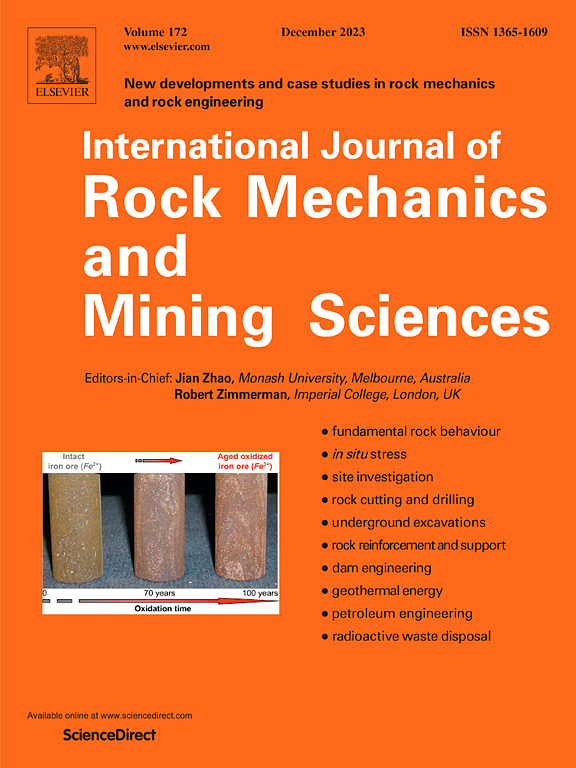Fatigue fracture behaviors and damage evolution of coal samples treated with drying–wetting cycles investigated by acoustic emission and nuclear magnetic resonance
IF 7
1区 工程技术
Q1 ENGINEERING, GEOLOGICAL
International Journal of Rock Mechanics and Mining Sciences
Pub Date : 2024-11-29
DOI:10.1016/j.ijrmms.2024.105976
引用次数: 0
Abstract
Constructing pumped-storage power stations using underground reservoirs in mines offers a promising method for large-scale energy storage. Watertight coal pillars have the potential to destabilize under the mine-shock cyclic dynamic loading and the drying–wetting cycles (DWCs). Understanding the fatigue damage mechanism and failure precursors in watertight coal pillars under cyclic dynamic loading disturbances in overburdened rock strata has become challenging. This study investigated the fatigue fracture behavior and precursor information of coal samples under acoustic emission (AE) monitoring over 1–7 DWC times. We analyzed the effects of DWC and fatigue cycles on the dynamic parameters and AE response, investigated crack spatial extension behaviors and the tensile-shear cracking evolution law, and analyzed the fatigue damage evolution law and failure precursor with energy and b-value. The results demonstrated that fatigue loading produced a strengthening effect on the DWC coal samples, and DWC promoted plastic softening damage to the specimens and increased the percentage of the elastic phase. The average dynamic fatigue strength and life of the specimens decreased exponentially under 7 DWC times. The average dynamic axial stiffness decreased by 15.67 %, the axial deformation increased by 6.1 × 10−4 in a single cycle, and the dynamic elasticity modulus of the fatigue damage instant decreased by 8.86 %. The greater the number of DWC, the smaller the b-value and the larger the fluctuation amplitude at fatigue failure of the specimen. A large short-term increase or decrease in the b-value can be regarded as a precursor to fatigue failure. This study provides a reference for the stability monitoring and forewarning of underground pumped-storage facilities.
利用声发射和核磁共振研究干湿循环处理煤样的疲劳断裂行为和损伤演化
利用矿山地下水库建设抽水蓄能电站是一种很有前途的大规模蓄能方法。水密煤柱在矿震循环动载荷和干湿循环作用下具有失稳的潜在危险。研究超载岩层中水密煤柱在循环动载荷扰动下的疲劳损伤机理和破坏前兆已成为一个具有挑战性的课题。研究了1 ~ 7 DWC次声发射监测下煤样的疲劳断裂行为和前驱体信息。分析了DWC和疲劳循环对动力参数和声发射响应的影响,研究了裂纹的空间扩展行为和拉剪裂纹演化规律,并利用能量和b值分析了疲劳损伤演化规律和破坏前兆。结果表明:疲劳加载对DWC煤样产生强化作用,DWC促进了试样的塑性软化损伤,增加了弹性相的比例;试件的平均动态疲劳强度和寿命在7 DWC次数下呈指数级下降。单周平均轴向动刚度降低15.67%,轴向变形增加6.1 × 10−4,疲劳损伤瞬间动弹性模量降低8.86%。DWC数越大,试件疲劳破坏时的b值越小,波动幅度越大。短期内b值的大幅上升或下降可视为疲劳失效的前兆。该研究为地下抽水蓄能设施的稳定性监测预警提供了参考。
本文章由计算机程序翻译,如有差异,请以英文原文为准。
求助全文
约1分钟内获得全文
求助全文
来源期刊
CiteScore
14.00
自引率
5.60%
发文量
196
审稿时长
18 weeks
期刊介绍:
The International Journal of Rock Mechanics and Mining Sciences focuses on original research, new developments, site measurements, and case studies within the fields of rock mechanics and rock engineering. Serving as an international platform, it showcases high-quality papers addressing rock mechanics and the application of its principles and techniques in mining and civil engineering projects situated on or within rock masses. These projects encompass a wide range, including slopes, open-pit mines, quarries, shafts, tunnels, caverns, underground mines, metro systems, dams, hydro-electric stations, geothermal energy, petroleum engineering, and radioactive waste disposal. The journal welcomes submissions on various topics, with particular interest in theoretical advancements, analytical and numerical methods, rock testing, site investigation, and case studies.

 求助内容:
求助内容: 应助结果提醒方式:
应助结果提醒方式:


